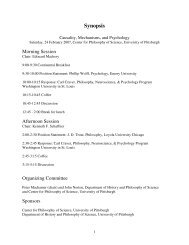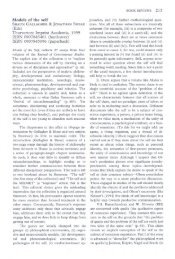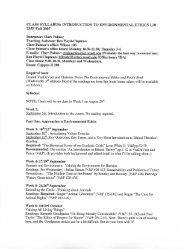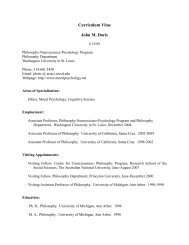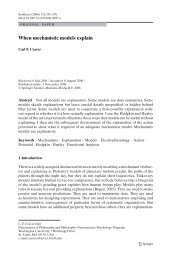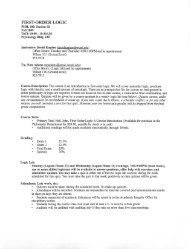The Blackwell Guide to the Philosophy of Science - The Department ...
The Blackwell Guide to the Philosophy of Science - The Department ...
The Blackwell Guide to the Philosophy of Science - The Department ...
You also want an ePaper? Increase the reach of your titles
YUMPU automatically turns print PDFs into web optimized ePapers that Google loves.
For <strong>the</strong> purposes <strong>of</strong> probing locality, <strong>the</strong> fac<strong>to</strong>rization condition is blunt. In his<br />
1983 dissertation – Jarrett (1986) provides a précis – John Jarrett sharpened it,<br />
by demonstrating its equivalence <strong>to</strong> <strong>the</strong> pair <strong>of</strong> conditions:<br />
Pr ( xa, b)= Pr ( xa)<br />
l l<br />
Pr ( xa, b, y)= Pr ( xa, b)<br />
l l<br />
Laura Ruetsche<br />
(Jarrett Locality)<br />
(Jarrett Completeness)<br />
<strong>The</strong> first expresses <strong>the</strong> desideratum that <strong>the</strong> outcome <strong>of</strong> a particle I measurement<br />
be independent <strong>of</strong> detec<strong>to</strong>r II’s setting (ergo Shimony’s (1984b) label: “parameter<br />
independence”). Jarrett equates it <strong>to</strong> a prohibition on superluminal signaling,<br />
which prohibition he supposes <strong>the</strong> special <strong>the</strong>ory <strong>of</strong> relativity (STR) <strong>to</strong> issue. If<br />
Jarrett Locality fails, by changing <strong>the</strong> setting <strong>of</strong> her detec<strong>to</strong>r, a physicist in labora<strong>to</strong>ry<br />
I can send instantaneously <strong>to</strong> labora<strong>to</strong>ry II a signal in <strong>the</strong> form <strong>of</strong> altered<br />
measurement statistics (Shimony calls this “controllable non-locality” or actionat-a-distance).<br />
Jarrett Completeness expresses <strong>the</strong> desideratum that <strong>the</strong> outcome<br />
<strong>of</strong> a particle I measurement be independent <strong>of</strong> <strong>the</strong> outcome <strong>of</strong> a particle II measurement<br />
(ergo Shimony’s label: “outcome independence”). Because <strong>the</strong> labora<strong>to</strong>ry<br />
I physicist has no control over labora<strong>to</strong>ry II outcomes, she can not exploit<br />
breakdowns in Jarrett locality <strong>to</strong> signal (Shimony call this “uncontrollable nonlocality”<br />
or “passion-at-a-distance”).<br />
<strong>The</strong> violation <strong>of</strong> <strong>the</strong> Bell Inequalities implies that one <strong>of</strong> <strong>the</strong> assumptions generating<br />
<strong>the</strong>m must be false. Having furnished his fac<strong>to</strong>rization <strong>of</strong> (10.3), and supposing<br />
our commitment <strong>to</strong> <strong>the</strong> special <strong>the</strong>ory <strong>of</strong> relativity <strong>the</strong>ory <strong>to</strong> commit us,<br />
at least morally, <strong>to</strong> Jarrett Locality, Jarrett fingers Completeness as <strong>the</strong> culprit<br />
(1986, p. 27). Setting l =|yÒ, standard quantum mechanics itself can be cast as<br />
a s<strong>to</strong>chastic hidden variable <strong>the</strong>ory violating completeness: |yÒsinglet makes particle<br />
I probabilities sensitive <strong>to</strong> particle II outcomes. It appears that <strong>the</strong> quantum<br />
domain is ruled by passion-at-a-distance. Enlisting a Lewis-style counterfactual<br />
analysis <strong>of</strong> causation, Butterfield (1992) has argued that this violation <strong>of</strong> Jarrett<br />
completeness signals a causal connection between distant wings <strong>of</strong> <strong>the</strong> aparatus.<br />
Much care has been lavished on articulating relativistic locality constraints suited<br />
<strong>to</strong> this s<strong>to</strong>chastic setting, so that <strong>the</strong> question <strong>of</strong> whe<strong>the</strong>r QM and <strong>the</strong> STR can<br />
“peacefully coexist” (Redhead, 1983) might be settled once and for all.<br />
No-Go results without locality<br />
I would advocate postponing <strong>the</strong> question. STR does not issue bans on superluminal<br />
causation. It does not address causation at all. It ra<strong>the</strong>r requires <strong>of</strong> that class<br />
<strong>of</strong> space–time <strong>the</strong>ories formulated in Minkowski space–time that <strong>the</strong>y be Lorentzcovariant.<br />
4 Non-relativistic QM, which is not a space–time <strong>the</strong>ory, is not subject<br />
<strong>to</strong> STR’s requirements. So <strong>the</strong> question <strong>of</strong> whe<strong>the</strong>r STR and QM can peacefully<br />
coexist is ill-posed. Ano<strong>the</strong>r question – can <strong>the</strong>re be Lorentz-covariant quantum<br />
<strong>the</strong>ories? – is well-posed. Quantum field <strong>the</strong>ory (QFT) associates observables<br />
204



